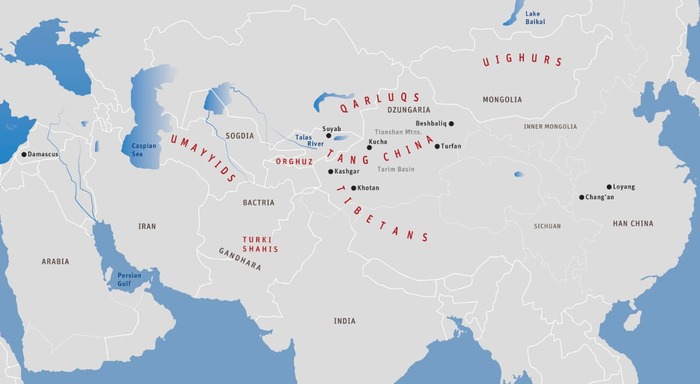The Regional Context
Before discussing historical developments during the early Abbasid caliphate, let us briefly review the political situation in Central Asia just before the dawn of this period. The Umayyads ruled Sogdia and Bactria, while the Tang Chinese army occupied the region to the north and west, in Suyab, Kashgar, and Kucha, threatening invasion. The Tang forces also held Turfan and Beshbaliq. The Oghuz Turks of White Dress had newly migrated from southern Mongolia to a remote northeastern corner of Sogdia. The rest of northern West Turkistan and Dzungaria were held by the Qarluqs, and Mongolia was newly under the control of the Uighurs.
Tang China and the Uighurs were allies. The Tibetans were in a weak position, but maintained a presence in the southern Tarim states, although the Khotanese king favored the Tang court. The former Tibetan allies, the Turgish, had been virtually eliminated. The only confederates left to the Tibetans were the Turki Shahis in Gandhara, nominally allied by marriage to Khotan.

The Founding of the Abbasid Caliphate
Although the two main Islamic sects, Sunni and Shia, did not formally crystallize until the eleventh century, for ease of discussion let us speak of their forerunners with these terms. The Murjiah movement, upheld by the Umayyads, was the forerunner of Sunni. It supported the caliphate line of succession from the Prophet’s brother-in-law, Mu’awaiya, the first Umayyad caliph. Shia evolved from the opposition faction, which claimed that legitimacy of succession traced from the Prophet’s cousin and son-in-law, Ali. Since the majority of Arabs supported the Umayyads and thus Sunni Islam, most non-Arab Muslims favored Shia.
The Umayyad caliphs were Arabs coming from the Arabian Peninsula. They favored Arabs in all respects, far more than Muslims in general. They forbade Non-Arab Muslim troops, for example, from sharing in booty gained from victory in battle. Non-Muslim Arabs, on the other hand, such as Christians or Jews from Arabia, were preeminently trusted over non-Arab Muslims. Some were even appointed as governors of non-Arab regions within the caliphate. This partisan policy caused huge resentment, especially among Iranian Muslims who considered themselves culturally superior to the Arabs.
Abu Muslim was a Bactrian convert to Shia Islam from Balkh. He became an associate of Abu l’A bbas, an Arab descendent of Abbas, an uncle of the Prophet, while both were imprisoned in Bactria (Khorasan) for anti-Umayyad activities. Drawing upon Iranian and Central Asian dissatisfaction and alienation, Abu Muslim later led a rebellion that overthrew the Umayyads in 750. After conquering Damascus, the Umayyad capital, he proclaimed Abu l’Abbas, also known as as-Saffah (r. 750 – 754), the first caliph of the Abbasid line. As a reward, as-Saffah appointed Abu Muslim governor of Bactria. The Abbasid Caliphate lasted until 1258, but ruled Bactria and Sogdia only until the mid-ninth century.
Since the Abbasid caliphs were Arabs from an Iranian cultural area, the Iranian and Central Asian Muslims initially supported their usurpation of power. Thinking that the Abbasids were distant enough from Arabia not to have the same racial prejudice as the Umayyads had, they hoped the new dynasty would no longer treat them as second-class citizens.
The Defeat of Tang China and the An Lushan Rebellion
In 751, Abu l’Abbas joined forces with the Qarluqs and turned against the Tang Chinese forces that were menacing both of them. They defeated the Tang army at the Talas River in present-day southern Kazakhstan, decisively ending Han Chinese presence in West Turkistan. This marked the turning of the tide, after which Han Chinese occupation and rule of East Turkistan gradually dwindled and ended as well.
The Tang defeat and the heavy cost of all Emperor Xuanzong’s seemingly fruitless campaigns in Central Asia finally became too overwhelming for the Chinese population to bear any longer. In 755, An Lushan (An Lu-shan), the son of a Sogdian soldier in Tang service and an Eastern Turk mother, led a popular revolt in the Tang capital, Chang’an. Although the Emperor recalled many of his troops from Kashgar, Kucha, Beshbaliq, and Turfan, leaving behind only a skeletal force, and received military assistance from the king of Khotan, he was unable to quash the rebellion. He was forced to flee in humiliation to the mountains of Sichuan. The Tang forces finally succeeded only by turning to the Uighurs in Mongolia for rescue.
While fighting the rebels in Chang’an and Loyang, the Uighurs pillaged and practically destroyed both cities, including the many Buddhist temples and monasteries found in each. Nevertheless, as a result of contact with the Sogdian merchant communities there, Bogu Qaghan, the Uighur emperor, adopted the Manichaean faith held by most of these merchants. He subsequently declared it the state religion of the Uighur nation in 762. Although An Lushan was half Sogdian, apparently the rebels were mostly Han Chinese and not from among the non-Han community. Otherwise Bogu Qaghan would have been fighting against the Sogdians as well and would therefore not have been receptive to their religion.
Over the course of several centuries, the Uighurs changed their state religion from shamanism first to Buddhism, then Manichaeism, and then back to Buddhism before finally converting to Islam. The Eastern Turks before them had exchanged shamanism for Buddhism and then reverted to shamanism. Let us examine some possible reasons for these changes of religion among these two Turkic peoples. It may help us to understand better the mechanics behind the later conversion of most Turkic tribes from Buddhism or shamanism to Islam.